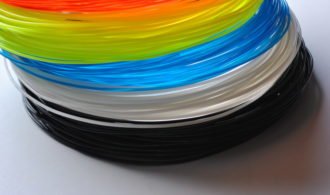3D printing has come a long way since its inception in the early 1980s, where rudimentary machines used custom ink-jet heads to apply layer upon layer in order to produce 3D objects. Meanwhile, several other similar processes were being pioneered utilising polymers, photopolymers and in some case, sand and metal. Whilst the technology was advancing, it was still used primarily in manufacturing industries for prototyping, tooling and casting.

From the mid-1990s, the pace of technological advance quickened and many sub-technologies emerged, each utilising their own materials and methods of producing 3D models. Today, almost all materials used in the processes are designed and engineered for a specific application and 3D printing technique. They come in all manner of states and sizes, from resins to powder and filaments.
This article takes a look at some of the most popular materials and their applications across a number of industries and professions. For more information of specific materials used in SLA or Stereolithography techniques, visit http://www.graphite.uk.com/.
Plastics
Typically used in powder or filament form, nylon is an extremely popular 3D printing material. Its popularity comes about due to its durability and flexibility that are not compromised by its strength. Naturally white in colour, it can be easily coloured making it incredibly useful in consumer products. It is sometimes combined with aluminium powders for added strength and use in industries such as automotive and aerospace.
PLA, a form of bio-degradable polyester is another increasingly popular 3D printing material. Derived from sustainable sources such as sugarcane or corn starch, PLA is one of the world’s most popular bioplastics. Available as a resin or in filament form and in a plethora of colours, it is also versatile as well as environmentally friendly.
Entry-level, consumer available 3D printers often use a polymer-wood composite known as LayWood. It also comes in filament form, is inexpensive and produce wood-like products in texture and strength.
Metals
Cobalt and aluminium alloys are the most common metals used in additive manufacturing and industrial 3D printing. Stainless steel, favoured for its strength and ductility is also used in powdered form. Stainless steel, a naturally silver metal, is easily bronzed or affected to give it a golden colour ideal for decorative purposes.
In recent years precious metals including gold and silver have also become popular 3D printing materials, meaning an entire new jewellery frontier has opened up in the industry. Both are used in powder form, but produce incredibly strong parts once printed.
Finally, arguably one of the toughest metals to be used in 3D printing is titanium. Popular in the aerospace and automotive industries, it is supplied as a powder and has been used in the industry for several years.
Bio-Medical
Bio-medical 3D printing is at the cutting edge of 3D printing technology and is pioneering the way forward in material engineering. Scientists are currently experimenting with the printing of live human cells and stem cells to be used in the production and manufacture of human organs, including skin and internal organs like the heart. Leading medical experts predict that within years the very first organ transplant will have taken place with an organ produced by a 3D printer.
Right now, the medical profession is able to manufacture complicated tools, instruments and prosthetics.
Ceramics
The 3D printing of ceramics is thus far limited by the fact that post printing, the objects must be fired in the same way a usual ceramic part is fired. Nevertheless, ceramics have been printed with varying degrees of success and research is ongoing in how this group of materials can be utilised in the world of additive manufacture.
Food
Finally, whilst still in the relatively early stages of research, 3D food printing has been proved feasible by a number of scientists across the world. Experiments with chocolate, pasta and even meat have thus far been successful, if not expensive. The real challenge now lies in developing technology that can produce food stuffs in a cost effective manner.
As you can see, the list of different materials is expansive and ever-growing. In the future new materials will be designed and manufactured to meet demands in a whole host of industries from medical to aerospace. Right now, notable research is on-going into new aluminium alloys and various living tissue and stem cell printing materials.




